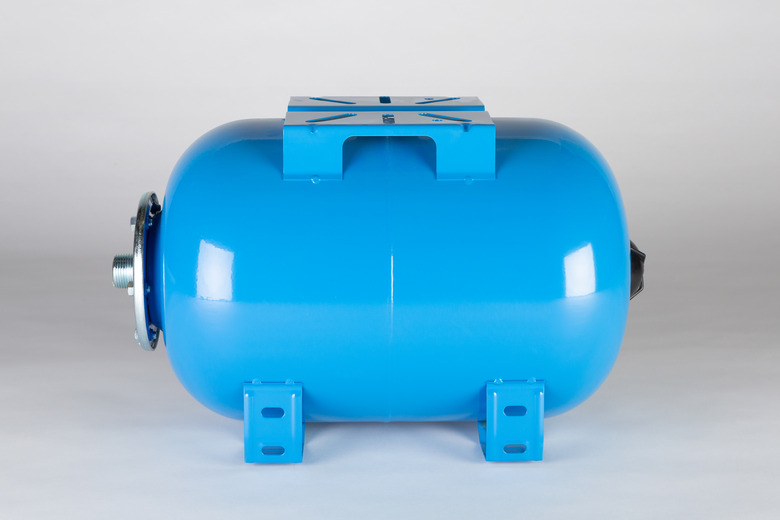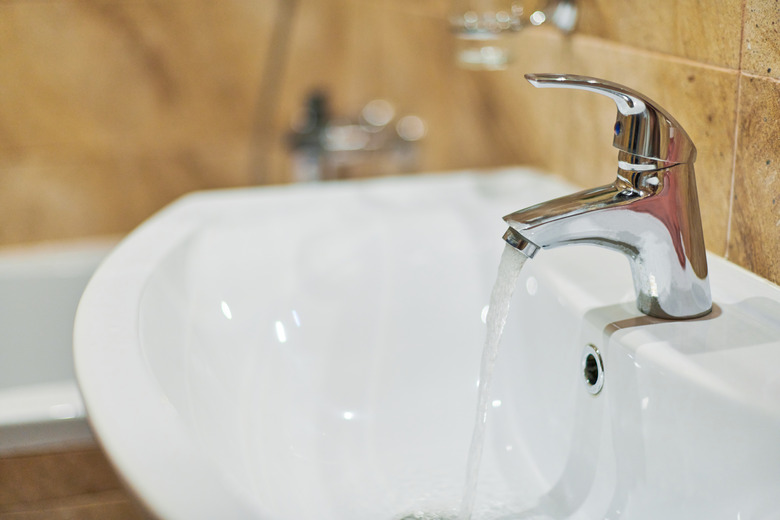7 Warning Signs Of A Bad Water Well Pressure Tank
We may receive a commission on purchases made from links.
If you get your water from a well, your well pump system probably includes a pressure tank. It's a cylindrical metal tank that is often painted sky blue, and if the volume it holds is 86 gallons, which is common, it stands about 4 feet tall and has a diameter of around 3 feet. It could be in the basement or outside depending on the climate, and the main water line that feeds your house is connected at the bottom.
The purpose of the pressure tank is to pressurize the water from the well. If your system didn't have one, the water coming straight into the house from the well or a holding tank would just trickle from faucets, and there wouldn't be enough water pressure to take a shower or use a washing machine. In fact, if your holding tank was at the same or a lower elevation as the house, no water would flow at all.
When a homeowner begins to have trouble with water pressure, the pressure tank may be responsible. It isn't always the culprit because other components of a water well system can also fail, but the pressure tank is a necessary stop in your troubleshooting journey.
How a Pressure Tank Works
How a Pressure Tank Works
Inside a pressure tank is a bladder or diaphragm that separates two chambers, one filled with air and one with water from the well. Well systems with pressure tanks, which includes most of them, also have a pressure pump, which may be the actual well pump or a separate jet pump. It pumps water into the bottom of the tank under pressure, and the air, which is at the top of the tank, compresses to maintain the pressure while a check valve prevents water from flowing back to the pump.
As you use water in the house, the pressure in the tank drops steadily until it falls below the cut-in pressure of the pump, which is typically 30 psi. A pressure switch monitors the pressure, and when it senses low pressure, the pump turns on to re-pressurize the tank to its cut-out pressure, which is typically 50 psi.
The most common problem with a bladder pressure tank or one that uses a diaphragm is a rupture in the bladder or diaphragm that lets water into the air compartment. The air dissolves into the water, the air pressure dissipates, and the tank can no longer maintain the water pressure at the desired value.
Here are seven DIY ways to diagnose this as the cause of your water woes.
1. Air Spurts From a Faucet
1. Air Spurts From a Faucet
When the bladder or diaphragm in a pressure tank ruptures and allows air and water to mix, some of that air will come out of the faucets. The faucets will spurt, and the flow may be uneven.
By itself, this isn't a conclusive indication of pressure tank problems because air can get into the pipes in other ways — for example, through a bad seal in the well pump or pressure pump. If a single faucet in your house is sputtering, it could indicate a leak in the plumbing for that faucet. However, sputtering is definitely an indication that you need to check the pressure tank.
2. Electricity Bill Goes Up
2. Electricity Bill Goes Up
One of the more subtle indications of pressure tank problems is a spike in your electric bill. This happens because the pressure pump is cycling on more often. If the pressure tank is completely waterlogged, meaning that the upper chamber has gotten full of water, the effect on the electric bill can be dramatic because the pump is rapid cycling or running virtually full time to maintain pressure.
Depending on the power rating of the pump motor (which can vary from 1/2 to 5 hp), the power consumption can be as much as 1,100 watts, which costs 12 cents or more per hour depending on power company pricing. California utility company PG&E, for example, has a tiered pricing system, which means the more electricity you use, the more you pay per kilowatt-hour. A pump cycling full time to pressurize a waterlogged tank can hike your electricity bill by an extra $85 to as much as $400.
3. The Pressure Gauge Fluctuates
3. The Pressure Gauge Fluctuates
A pressure gauge is usually mounted on the tank or the pressure pump, and watching this gauge while the pump is running is another way to diagnose a bad pressure tank. When the tank is good, the needle on the gauge should rise steadily when the pump is running. If the tank bladder is ruptured, however, the needle will bounce back and forth while the pump is running. It may or may not remain stationary when the pump switches off, and it will start falling quickly as soon as someone turns on a faucet.
4. Strange Noises
4. Strange Noises
Sometimes, the pressure switch responds to fluctuations in pressure caused by a ruptured bladder by clicking repeatedly. If the switch is mounted inside the tank (as it is in some cases), the clicking sounds will be coming from there.
One way to check for a waterlogged tank is to tap lightly on the tank walls using your knuckles or a hammer, starting at the bottom and working toward the top. If the tank is good, you'll hear a dull thump at the bottom, which is full of water, and a hollow sound near the top, which is full of air. If you hear a dull thump no matter where you tap, it means the tank is full of water.
5. Water Spurts From the Air Valve
5. Water Spurts From the Air Valve
Every pressure tank has an air valve on top that is similar to the air valve on a bike or car tire. When you remove the cap and press the valve with your finger, only air should come out. If your finger gets wet or you can actually see water spurting from the valve, it means there's water in the air chamber.
6. Scalding Showers
6. Scalding Showers
If you don't have pressure compensating shower valves, you may get scalded in the shower. This is due to fluctuations in the cold water supply caused by air in the pipes while the water flow from the water heater remains constant.
7. Loss of Water Pressure
7. Loss of Water Pressure
When you lose water pressure completely, the first thing to do is check the circuit breaker for the well or pressure pump to make sure it hasn't tripped. If you have a filtration system, you should also make sure the filter hasn't clogged with sediment. Turn your attention to the pressure tank when you're sure everything else is working properly.
If the pressure tank shows signs of being waterlogged, you may be able to restore pressure temporarily until the plumber arrives. You may be able to replenish the air charge by pumping air into the air valve with a compressor or bicycle pump. Keep your eye on the pressure gauge while you add air to make sure you don't add too much. You don't want to overpressurize your pipes and cause a leak.


